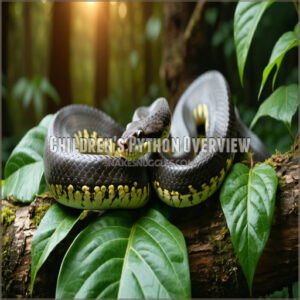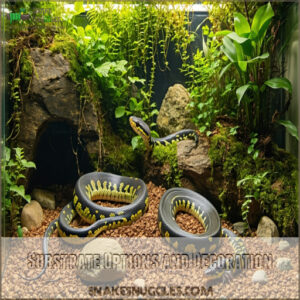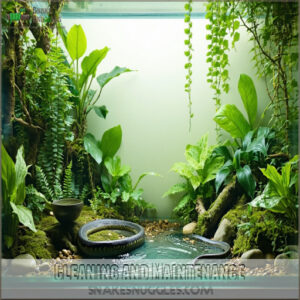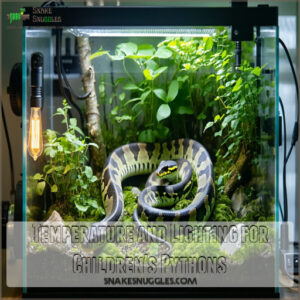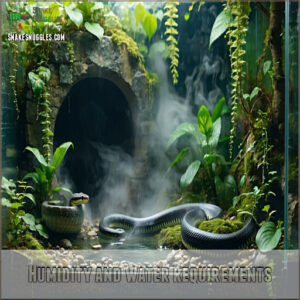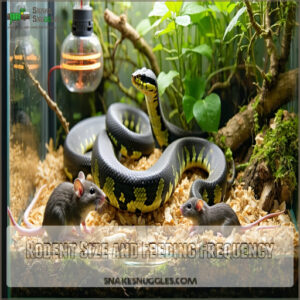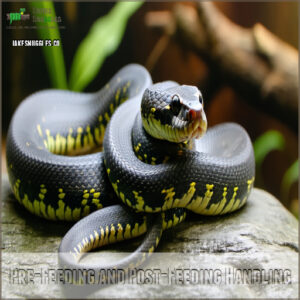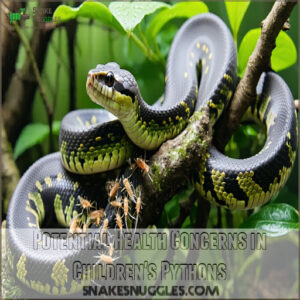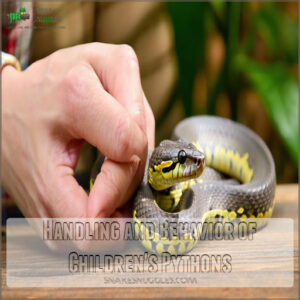This site is supported by our readers. We may earn a commission, at no cost to you, if you purchase through links.
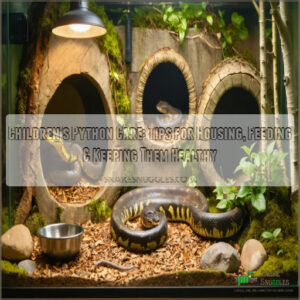
These small, gentle snakes need a cozy enclosure—around 20 gallons for an adult—kept warm (with a basking spot) and humid (50-70%).
Give them hiding spots and a comfy substrate, like aspen or cypress mulch, to feel at home.
They thrive on frozen-thawed mice or rats, sized to their thickest body part.
Feed younger snakes weekly, but adults can eat every 2-3 weeks.
Keep their water bowl clean and watch for health issues like parasites or respiratory infections.
With proper care, they’ll be your scaly buddy for up to 30 years!
Table Of Contents
- Key Takeaways
- Children’s Python Overview
- Choosing and Buying a Children’s Python
- Housing Children’s Pythons
- Temperature and Lighting for Children’s Pythons
- Humidity and Water Requirements
- Top 6 Products for Children’s Python Care
- Diet and Feeding for Children’s Pythons
- Potential Health Concerns in Children’s Pythons
- Handling and Behavior of Children’s Pythons
- Breeding and Reproduction of Children’s Pythons
- Frequently Asked Questions (FAQs)
- How do you care for a child Python?
- How is the python being taken care of in its new home?
- Do children pythons need maintenance?
- How do you handle a children’s Python?
- Do children’s pythons like to be held?
- What do I need for a Childrens Python?
- What size tank does a Childrens Python need?
- Do children’s pythons make good pets?
- What do I need for a children’s Python?
- How big of a tank does a children’s Python need?
- Conclusion
Key Takeaways
- Set up a secure enclosure with a basking spot, proper substrate like cypress mulch, and consistent humidity levels (50-70%) to keep your Children’s python healthy.
- Feed frozen-thawed mice or rats weekly for young snakes and every 2–3 weeks for adults, and always match prey size to the snake’s widest part.
- Create a thermal gradient with a warm basking spot (88–90°F) and a cooler side (72°F), using a thermostat to maintain precise control.
- Handle your python gently, avoid sudden movements, and give them 48–72 hours to digest after feeding to ensure a stress-free bond and proper health.
Children’s Python Overview
Children’s pythons are small, calm snakes from Australia, known for their reddish-brown bodies and gentle nature.
They’re perfect for beginners because they’re easy to care for and rarely grow longer than three or four feet, which makes them a great example of small snakes.
Origin and Distribution
Dreaming of an Aussie touch in your terrarium?
The Children’s python (Antaresia childreni) comes straight from Australia’s rugged north.
These adaptable snakes call home:
- Woodlands and grasslands – Perfect for their climbing and basking instincts.
- Wetlands and forests – Offering shade and prey galore.
- Semi-arid regions – Ideal for their resilience.
Native to Queensland, the Northern Territory, and Western Australia, these Australian natives thrive in diverse habitats.
Size and Lifespan
Children’s pythons are pocket-sized powerhouses, maxing out at 3-4 feet long—perfect for tight spaces.
With proper python care, these snakes stick around, boasting a lifespan expectancy of up to 30 years.
Their growth patterns start fast, especially in the first two years, then taper off.
Weight management is easy because they’re naturally petite, and if you’re ready for long-term snake care, this little python’s size limits make them a keeper!
Temperament and Behavior
These guys may look a little spooky, but their docile temperament makes them perfect for beginners.
With a personality as mellow as a lazy weekend, they rarely get defensive unless startled or stressed.
That’s great for handling, just go slow and steady.
Ever notice their python behavior?
When they’re chill, you’ll see relaxed muscles and slow, curious exploration.
To keep them calm, remember:
- Handle with two hands, supporting their body.
- Avoid sudden movements.
- Skip handling after feeding or shedding.
- Pay attention to subtle personality quirks.
Snake socialization is all about patience!
Choosing and Buying a Children’s Python
When choosing a Children’s python, you’ll want to look for a healthy snake with clear eyes, smooth skin, and no signs of wheezing or lethargy.
Stick to reputable breeders or specialty reptile shops to guarantee you’re getting a well-cared-for pet, not one with hidden health issues, and consider a healthy snake as your top priority.
Factors to Consider
Picking out a Children’s Python? Smart move! But don’t rush it—consider these key tips first:
- Snake Habitat Needs: Do you have space for a proper python enclosure setup, ideally 20+ gallons?
- Time Commitment: Feeding tips, health checks, and cleaning take regular attention. Is your schedule flexible?
- Long-Term Costs: Can you handle setups, vet bills, and mouse buffets?
- Python Behavior & Handling: Are you comfortable with calm but occasionally squirmy snakes?
Start strong for lasting, safe fun!
Reputable Breeders and Prices
Finding a reputable breeder is the first step to snagging a healthy, happy Children’s python.
Prices typically range from $75–$300 depending on the breeder’s reputation, snake availability, and market trends.
For ethical breeders, learn more at this Ball Python Breeders resource.
Look for ethical standards like health guarantees, secure payments, and buyer reviews.
Don’t be shy—ask about feeding logs and care tips.
Many breeders, like CB Reptiles or XYZReptiles, even offer live arrival guarantees, making buying your new snake simple and stress-free.
Age and Color Variations
Age brings fascinating transformations to this python species.
Juvenile Children’s pythons flaunt bold, leaf-like markings and lighter hues, while adults mellow into rich reddish-brown tones through an amazing maturation process.
Watching their pattern changes and hue shifts is like seeing a living masterpiece evolve.
- Vibrant juveniles: Expect brighter patterns during early growth.
- Subtle adults: Over time, their python coloration develops deeper shades.
- Color morphs add variety: Some breeders offer unique python appearances.
- Growth milestones: They peak in size—3-4 feet—within two years.
- Photo fun: Snap monthly pics to track age factors and changes.
Housing Children’s Pythons
Giving your Children’s python the perfect home is easier than you think—it just takes the right setup and some planning.
A secure, roomy enclosure with the right temperature, hiding spots, and a comfy substrate will keep your snake happy and healthy, which includes providing a secure environment.
Enclosure Size and Material
Setting up a childrens python enclosure? Start with at least a 20-gallon tank for adults or 10 gallons for juveniles.
Glass, plexiglass, or durable plastic works best. Skip wood—it traps moisture and invites mold.
Always secure the lid; these sneaky escape artists test every latch! For added climbing fun, make certain at least 24 inches in height.
Check out this comparison:
| Material | Pros | Cons |
|---|---|---|
| Glass | Great visibility | Heavier to move |
| Plexiglass | Lightweight | Scratches easily |
| Plastic | Easy to clean | Less attractive look |
Substrate Options and Decoration
The right substrate materials make or break your python enclosure setup.
Go for cypress mulch, shredded bark, or coconut fiber—they hold humidity and feel like home to your snake.
Add flair with climbing structures and plant arrangements to keep things natural and engaging.
Choosing the best reptile substrate options is essential for maintaining a healthy environment.
Here’s how to decorate:
- Use decorative rocks or hideaway designs for cozy spots.
- Add sturdy branches and non-toxic faux plants for climbing fun.
- Try bioactive setups with isopods for low-maintenance cleaning.
It’s practical and stylish, with the right reptile substrate options and climbing structures creating a natural and engaging environment for your snake.
Cleaning and Maintenance
Keeping your Children’s python’s home clean is essential for their health, but it’s not hard if you stay on top of it.
Here’s a simple habitat sanitation routine you can stick to:
- Spot-clean waste daily to remove poop, shed skin, and food debris.
- Wash the water bowl daily, scrubbing weekly to prevent bacteria buildup.
- Deep-clean the enclosure monthly with reptile-safe disinfectant.
- Replace the substrate every 2-3 months—unless it’s a bioactive setup; then, let nature thrive!
Your snake deserves a clean jungle retreat!
Temperature and Lighting for Children’s Pythons
Your Children’s python needs the right temperature and basking zone to stay happy and healthy, kind of like how we all need our cozy spots to relax.
Aim for a warm basking zone, a cooler area to chill, and consistent lighting to mimic their natural day and night cycles.
Temperature Gradient and Basking Area
Think of your python’s home like a fancy spa.
You’ll need a cozy cool side (72°F), a warm side (85°F), and a luxury basking spot at 88–90°F.
Heat sources like lamps or pads create this thermal gradient, but don’t guess – grab a reliable thermostat for spot-on temperature control.
Without this, you risk overheating.
Smart heat distribution keeps your python comfy and stress-free.
They’ll thank you with happiness…and maybe a little climb toward that perfect basking spot!
Maintaining the right temperature gradient levels is essential for the overall health and well-being of your pet.
UVB/UVA Lighting and Photoperiod
Let’s talk lights! While UVB lighting isn’t a must, it’s like the bonus round for your Children’s python—boosting natural behaviors and health.
Stick with a low-output UVB bulb (2-5%) to avoid overdoing it.
Follow these tips:
- Keep lighting cycles at 12 hours on, 12 hours off for balance.
- Replace bulbs every 6-8 months (even if they still glow).
- Put bulbs 9-14 inches above basking spots.
For effective childrens python care, it’s vital to research and understand the specific lighting needs of your pet.
Heating Pads and Heat Lamps
Proper heat sources keep your python comfy.
Use heating pads to cover 30-40% of the enclosure floor for even heat distribution.
Add a 50-75 watt heat lamp above for basking—your snake will love it.
Pair these with a thermostat to prevent overheating; trust me, it’s a lifesaver.
Temperature control is everything.
Set up clear temperature zones, and skip UVB lighting unless you’re feeling fancy—it’s not essential.
When selecting a heating solution, consider the benefits of a reptile heating pad for ideal thermal regulation.
Humidity and Water Requirements
Keeping the humidity just right is key to your Children’s python’s health, as it helps with shedding and prevents dryness.
Make sure they’ve fresh water and a cozy hide with moisture to stay happy and hydrated.
Humidity Levels and Hideaways
Regarding humidity control, aim for 50-70% humidity levels in your python enclosure, nudging closer to 70% during shedding.
Hideaways are like cozy bedrooms for your snake – one on the warm side with moist sphagnum moss and another on the cool side will do the trick.
Use a digital hygrometer to keep an eye on reptile humidity, and adjust misting routines as needed.
Water Bowl and Hydration
A solid water bowl is your snake’s hydration hub, so go for a heavy ceramic one that won’t tip over.
Make sure it’s big enough for soaking but shallow enough to avoid accidents.
Clean water is non-negotiable—change it daily, especially if debris or poop shows up.
Dehydration? Look for wrinkly skin or stuck shed.
Keeping humidity levels steady helps too, think of hydration tips as insurance for your python’s health.
Misting and Fogging Systems
Keeping humidity levels just right doesn’t have to be a hassle.
Fogging systems like the Repti Zoo Fogger make humidity control a breeze, running on timers to keep moisture consistent.
Prefer a low-cost option? A manual pressure sprayer works great for misting – plus, it’s a mini arm workout.
Whatever you choose, clean spray nozzles monthly to avoid clogs.
Balanced humidity isn’t just water cycling; it’s peace of mind for your snake, and understanding a reptile fogger system is essential to maintain the right environment with ideal results.
Top 6 Products for Children’s Python Care
Finding the right products for your Children’s python is super important to keep them comfy, happy, and healthy.
Let’s look at six must-haves for their care, from a cozy terrarium to a handy mister system—it’s like building the ultimate snake spa!
1. Reptizoo 120 Gallon Reptile Terrarium
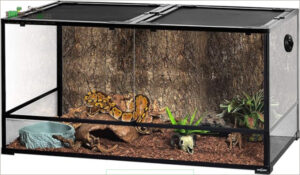
When setting up your Children’s python’s home, the Reptizoo 120-Gallon Reptile Terrarium checks all the right boxes.
Its roomy 48” x 24” x 24” dimensions mean your snake has plenty of space to stretch out, climb, and explore—a must for any python enclosure setup.
Plus, with its 360° clear glass view, you’ll enjoy watching your snake’s antics from every angle.
This vivarium makes habitat creation a breeze.
The sliding front doors make feeding or cleaning easy, while the raised bottom accommodates heating pads without hassle.
The secure screen top isn’t just escape-proof; it’s also breathable, keeping things well-ventilated.
Some useful perks?
- Sturdy glass construction, perfect for large reptiles.
- Generous space for enrichment decor or hides.
- Waterproof base, great for humidity retention.
- Easy assembly with detailed instructions.
- Pet-safe anti-escape locks.
It’s childrens python care made simple.
2. Vivosun Reptile Heating Pad With Thermostat

The Vivosun Reptile Heating Pad is a game-changer for maintaining your Children’s Python’s ideal temperature.
This heating pad keeps things cozy with its far-infrared tech and an adjustable digital thermostat, making reptile temperature control a breeze.
It’s super simple to install thanks to its flexible design and 3M adhesive, though heavier enclosures may need extra support.
The water-tight IP67 surface makes cleaning hassle-free, adding peace of mind to heating pad safety.
Just watch out for potential thermostat glitches after extended use.
For small reptiles needing consistent warmth, this heating pad helps create a perfect thermal gradient in lighter enclosures.
3. Flukers Reptile Heat Lamp 60 Watt
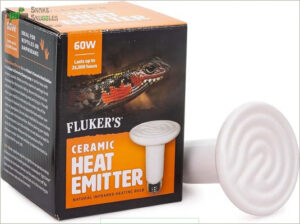
If you’re looking for a solid heat source for your Children’s python, Fluker’s 60-Watt Ceramic Heat Emitter is a great pick.
It delivers steady infrared heat without any light, so your python’s day-night cycle stays just right, and its circular design spreads warmth evenly, making basking a treat.
Hook it up with a Repta-Clamp Lamp for simple setup and reliable thermal control.
While perfect for most enclosures, this wattage might fall short for jumbo tanks, so consider wattage options for larger spaces.
Always pair it with a thermostat to avoid overheating—safety first.
With its durable design, this heat lamp guarantees your reptile heating needs are covered.
4. Zoo Med Reptisun LED Terrarium Light

A good light setup can make all the difference in your python’s habitat.
The Zoo Med Reptisun LED Terrarium Hood brings serious game to reptile lighting.
It’s got everything – bright 6500K daylight for a natural vibe, blue LEDs for soft nighttime illumination, and red LEDs to boost plant growth.
Its modular design means you can swap out panels if needed, making it a long-lasting choice.
Plus, the adjustable rails make terrarium setup a breeze for different tank sizes.
One heads-up: the stand’s legs can get a bit wobbly when extended, but nothing a little care won’t fix!
Zoo Med products deliver quality python habitat setups, no question.
Understanding the python care basics is essential for creating a thriving environment for your pet.
5. Zilla Reptile Habitat Timer Thermostat

In regards to keeping your Children’s python comfy and safe, Zilla’s Reptile Habitat Timer Thermostat is a lifesaver.
Its 8 outlets let you handle reptile lighting, heat lamps, and more without the usual cord chaos.
With 4 constant and 4 timed outlets, you can automate day-night cycles effortlessly—perfect for precise habitat control.
The digital timer might take a bit of patience to program, but once it’s set, you’re golden for years (seriously, some people report 14+ years of use!).
At about $22, it’s an affordable way to nail temperature regulation and perfect your python habitat setup.
6. Repti Zoo Reptile Mister Fogger System
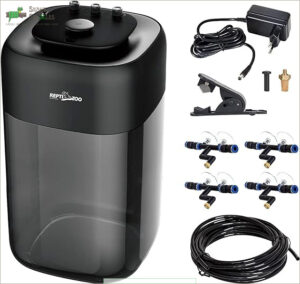
A reliable misting system can make python care so much easier, and the Repti Zoo TR05 Fogger is a solid pick for larger reptile enclosures.
With a big 10L tank, adjustable 360° nozzles, and super silent operation, it’s like having a perfect little rainforest for your Children’s Python.
The timer takes the guesswork out of fogging schedules, keeping humidity control on point.
Sure, occasional nozzle leaks or sticking happen, but they’re easy fixes.
The powerful spray might overwhelm smaller setups, but for bigger spaces, it’s golden.
Plus, it helps with reptile hydration and overall reptile husbandry.
Perfect python maintenance!
Diet and Feeding for Children’s Pythons
Feeding your Children’s python is pretty simple, but there are a few key things to get right.
Stick to frozen-thawed mice or rats, sized to match the snake’s middle, and you’ll keep them happy and healthy!
Frozen-Thawed Prey and Feeding Schedule
Feeding your Children’s python can be easy with a good python diet plan.
Stick to frozen-thawed prey for the safest snake nutrition.
It’s safer than live prey and way less stressful—for both of you!
Here’s a foolproof feeding routine:
- Seal frozen prey in a bag and thaw in the fridge for 6-8 hours.
- Warm it to room temperature in water (not too hot!) for 20-30 minutes.
- Offer it confidently—your snake will thank you!
Never refreeze uneaten food or microwave prey.
Safety first!
Rodent Size and Feeding Frequency
Figuring out the right prey size for your python doesn’t need to be tricky.
Use this simple rule: the prey should be close to your snake’s widest point—1.5 times tops.
Start small with pinky mice for young ones weekly, then gradually bump up to a large mouse or small rat every 14-21 days for adults.
Always check feeding charts for meal frequency and verify proper rodent sizing.
A steady python diet plan keeps your snake happy, healthy, and thriving—snake nutrition made easy, ensuring a steady python diet plan and proper rodent sizing.
Pre-Feeding and Post-Feeding Handling
Handling your snake the wrong way during meals can upset their tummy—and yours too.
Smart prefeeding and postfeeding habits make for happy pythons:
- No handling for 24 hours before feeding—it reduces snake stress.
- Feed in peace; watch quietly, no poking or prodding.
- Never grab them mid-bite; you only risk a hangry python.
Give them 48-72 hours to digest before any handling.
Factors like meal size, species, and a snake’s health influence their digestion time, so consider these when planning your post-feeding handling practices.
Watch for tweaks in behavior or stress, like sudden movement or hissing.
Stick to these python feeding tips for smooth, stress-free digestion!
Potential Health Concerns in Children’s Pythons
You’ll want to keep an eye on your Children’s python for common issues like mites, respiratory problems, and scale rot that can pop up even with the best care.
Just like us needing regular checkups, your scaly friend needs routine health monitoring and quick action if you notice anything unusual in their eating, breathing, or behavior.
Parasites and Scale/Mouth Rot
Parasite control matters because mites can hitch a ride on your python, hiding near their water bowl or eyes.
Snake mites look like tiny black specs—you might catch your snake soaking to escape them.
Python health issues like scale rot or mouth infections are no picnic either.
Discolored, missing scales or cheesy mouth discharge scream trouble.
Spot-check daily, keep things clean, and skip the fungal diseases by staying on top of the enclosure’s humidity and hygiene.
Respiratory Infections and Obesity
If your python’s wheezing, blowing nose bubbles, or breathing with its mouth open, it’s likely dealing with snake respiratory infections.
Keep enclosure humidity steady to stop these pesky python respiratory problems.
Overfeeding? That’s a fast pass to python obesity and serious struggles like poor digestion and sluggish movement.
- Stick to a strict feeding schedule.
- Resist feeding oversized rodents (despite those big eyes!).
- Monitor breathing problems, appetite, and activity levels to avoid sneaky python health issues spiraling out.
Veterinary Care and Preventative Measures
Keeping your python healthy starts with regular health checks.
Spotting python parasites, snake mites, or early signs of disease like respiratory problems means taking quick action.
Schedule annual vet visits, including diagnostic tests for python diseases and a general wellness exam—think of it as a “snake tune-up”!
Stay ahead of trouble with consistent enclosure cleaning, which helps with disease prevention.
And hey, when in doubt about medical emergencies, an exotic vet is your go-to lifeline.
Handling and Behavior of Children’s Pythons
When handling your Children’s python, go slow and keep things calm—they’re naturally gentle but can get spooked if rushed.
Pay attention to their body language, and soon enough, you’ll build trust and enjoy their curious, laid-back personality.
Handling Techniques and Safety Precautions
Handling your Children’s python can be a breeze if you follow a few key python safety tips.
These snakes are calm, but they still need a gentle touch and the right technique to feel secure.
Here’s a quick python handling guide to keep things smooth:
- Support their entire body to avoid stress.
- Approach from the side, never from above—they’ll think you’re a predator!
- Handle gently but firmly, and avoid sudden movements.
- Limit handling to 10 minutes or less per session.
- Wait 48 hours after feeding to prevent regurgitation.
Master these snake care basics, and you’ll build trust effortlessly!
Temperament and Body Language
Your snake’s behavior is the best way to understand its mood.
A calm python shows smooth, slow movements with a loose grip—kind of like a chill buddy hanging out.
Stress signals? Look for tight coils, rapid tongue flicks, or head hiding.
An S-shaped posture and raised head mean they feel threatened.
During feeding, quick movements and laser focus take over.
Pay attention to their body posture—it’s like reading a reptile’s feelings in real-time, understanding their body posture!
Socialization and Trust Building
Building a bond with your Children’s Python is kind of like making a shy friend—it takes time, patience, and trust exercises.
Start small with just 5-minute handling sessions in a calm environment, then slowly work your way up.
Pay attention to body language, as it’ll guide you.
- Move slowly—gentle handling is key.
- Stick to a routine—same time each day builds trust.
- Avoid handling after meals or during shedding—they’re moody then!
- Respect their limits—some days, they’re just not into it.
Be consistent, and you’ll see their confidence grow!
Breeding and Reproduction of Children’s Pythons
Breeding Children’s pythons can be a fascinating part of their care if you’re ready for the responsibility.
With the right temperature and humidity, and a little patience, you’ll help these snakes produce healthy eggs and thriving hatchlings.
Sexual Maturity and Breeding Conditions
Breeding a Children’s python is exciting but requires planning.
These snakes hit sexual maturity at 2-3 years and need the right conditions to thrive.
| Factor | Males | Females |
|---|---|---|
| Age | 2+ years | 2.5+ years |
| Weight | 500g+ | 800g+ |
| Breeding Season | Fall-Winter | Fall-Winter |
| Temperature | 75-80°F | 75-80°F |
| Health | Active, eating well | Regular shedding |
Understanding their breeding cycles and meeting proper breeding conditions guarantees successful python reproduction.
Incubation and Hatching
Hatching snake eggs is like watching tiny miracles unfold!
To ace egg incubation, you’ll need precision and patience.
Keep the incubator steady at 90°F with a cozy 90% humidity—use a thermostat for temperature control.
For more details, explore this detailed ball python egg incubation guide.
Here’s a quick checklist:
- Place python eggs gently in a sealed container with humid substrate.
- Check for decaying eggs weekly.
- Never rotate the eggs—they’re delicate!
- Expect hatchlings after 55-60 days.
- Let them emerge naturally—assist only if necessary.
Egg incubation done right means happy python neonates!
Neonate Care and Growth
Baby pythons, or neonates, need careful attention to thrive.
Start by setting them up in tiny, secure enclosures with high humidity.
After their first shed (around 7-10 days), they’re ready for food!
Follow this checklist for early development:
- Offer pinky mice every 5–7 days for Neonate Feeding.
- Maintain steady temps at 88-90°F, with humidity at 70%.
- Monitor growth rates—they should double in size within six months.
- Handle gently until they’re confident feeders.
- Keep clean enclosures with hides and water bowls.
Easy, right?
Frequently Asked Questions (FAQs)
How do you care for a child Python?
Caring for a Children’s python is like creating the coziest spa for your snake.
Set up a warm, secure enclosure, feed frozen-thawed mice, maintain humidity, and handle gently to keep it happy.
How is the python being taken care of in its new home?
You’re keeping it cozy by setting up the right temperatures, giving space to hide and climb, and feeding frozen-thawed prey.
With clean water, proper humidity, and gentle handling, your python feels right at home!
Do children pythons need maintenance?
Pythons aren’t exactly self-cleaning ovens, are they?
Yep, Children’s pythons need care—regular feeding, clean enclosures, proper humidity, and temperature checks.
It’s manageable, though, with a little routine, they’ll thrive and stay happy!
How do you handle a children’s Python?
Always support the whole snake, moving slowly to avoid startling it.
Skip touching the head—it’s the “no thanks” zone!
Handle them gently for short sessions, keeping it mellow, especially after meals.
Patience builds trust!
Do children’s pythons like to be held?
Holding a Children’s python is like cradling a noodle with curiosity—they’re calm but not exactly snuggle experts.
They tolerate handling, especially when you’re gentle and patient, but they’d much rather explore than cuddle.
What do I need for a Childrens Python?
You’ll need a secure enclosure, heating elements, a thermometer, substrate like cypress mulch, hide spots, climbing branches, and a water bowl.
Don’t forget frozen-thawed mice for feeding and some patience for handling practice.
What size tank does a Childrens Python need?
Your Children’s python will thrive in a 20-gallon tank as a minimum, but aim for a 3x2x2-foot enclosure for adults.
Bigger is better—more room means happier climbing, exploring, and hiding for your scaly buddy!
Do children’s pythons make good pets?
Did you know most Children’s pythons grow just 3–4 feet long?
These calm, nonvenomous snakes are great beginner pets—easygoing, low-maintenance, and small enough to handle without fuss.
Plus, they’re surprisingly cute for a snake, and overall make great pets.
What do I need for a children’s Python?
You’ll need a secure enclosure, cozy hides, proper substrate (like cypress mulch), a heat lamp, a thermostat, and humidity control.
Toss in climbing branches and water, and you’ve got yourself a happy python.
How big of a tank does a children’s Python need?
Imagine this: your python lounging in a 3x2x2-foot tank, like its own little mansion.
That’s the sweet spot for adults, giving them ample room to stretch, climb, and feel right at home.
Conclusion
Caring for a children’s python might sound tricky at first, but it’s really about following the basics—good housing, steady temperatures, proper humidity, and a clean water bowl.
Add regular meals and a cozy hide, and you’ve got a happy snake.
Keep an eye out for health issues like parasites or infections, and you’ll enjoy their company for decades.
These gentle, low-maintenance reptiles are perfect for beginners, making children’s python care as rewarding as it’s fun!
- https://www.thebiodude.com/blogs/reptile-and-amphibian-caresheets-with-cited-veterinary-and-herpetology-sources/bioactive-childrens-python-care-sheet
- https://reptilesupply.com/blogs/snake-care-sheets/how-to-care-for-your-children-s-python
- https://dubiaroaches.com/blogs/snake-care/children-s-python-care-sheet
- https://www.amazingamazon.com.au/pages/children-python-care-sheet-and-information
- https://www.reddit.com/r/snakes/comments/1cfcbva/childrens_python_care/

